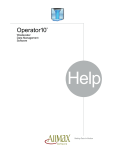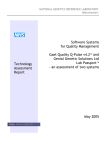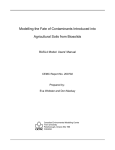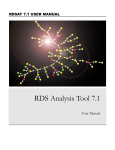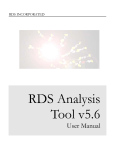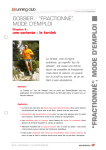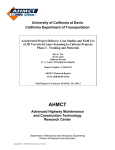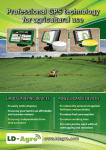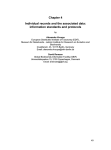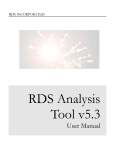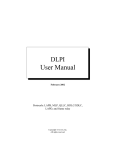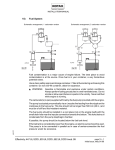Download Stranahan Arboretum User Manual
Transcript
Stranahan Arboretum User Manual 4131 Tantara Drive Toledo, Ohio 43623 419-841-1007 http://utoledo.edu/as/arboretum Contact Information: Daryl Dwyer, Professor & Director Room #1550 Stranahan Arboretum Arboretum Office: 419-841-1007 Department of Environmental Sciences University of Toledo, Toledo OH 43606 Campus Office: 419-530-2661 Campus FAX: 419-530-4421 E-Mail: [email protected] Pamela Struffolino Room #1600 Stranahan Arboretum Arboretum Office: 419-841-1007 E-Mail: [email protected] Walter Schulisch, Horticulturist Room #1200 Arboretum Office: 419-841-1007 E-Mail: [email protected] Department of Environmental Sciences University of Toledo, Toledo OH 43606 Department Office: 419-530-2009 Emergency Numbers Sylvania Township Police 911 UT Campus Police 419-530-2600 UT Health and Safety 419-530-3620 or 419-383-3768 1 Table of Contents Contact Information .........................................................Cover Page General Information ..................................................................... 3 General Use Guidelines ................................................................. 4 First Floor Layout ........................................................................ 5 Second Floor Layout ..................................................................... 6 Map of Grounds .......................................................................... 7 Electrical & Water Sources ............................................................. 8 Use of Chemicals/Harzardous Materials .............................................. 9 Collection Policy ....................................................................... 10 Emergency Procedures ................................................................ 11 Public Reservation Process ........................................................... 12 Arboretum Grounds Research Projects ......................................... 13-15 2 General Information Brief Description and History of Facilities The University of Toledo holds the Stranahan Arboretum in trust, a gift from the family of W. W. Knight (heir to the founders of Champion Spark Plugs). Mr. Knight married Elsie, daughter of R. A. Stranahan. Elsie dedicated the facility in her father's name. The original estate, bordered by Wildwood Metropark to the south, was a hobby farm and included fields, horse stables, a pool and tennis courts. The I-475 highway construction in the 1960s took a large portion of that land and 50+ acres was given to the University of Toledo. The largest portion (47 acres) holds the arboretum collection north of Sylvania Avenue. The second 5-acre portion contains a section of 10 Mile Creek (Ottawa River) and river bottomland south of Sylvania Avenue. In the main portion of the arboretum, there are approximately 15 acres of woodlot (160+ years old), a restored prairie, two ponds, as well as the collection of trees placed in a mown lawn. Most of the collection area was formerly used for agricultural purposes. Although there are no agriculture, forestry or horticulture departments at the University of Toledo, the Department of Environmental Sciences (EEES) was formed on July 1, 2000. It has since been expanding its research and educational programs in environmental studies at the arboretum. The Stranahan Arboretum also supports educational programs for local area highschool science classes, teacher workshops, and courses from nearby community colleges and technical schools. Mission Statement The central mission of the Stranahan Arboretum is to support research, formal education and public education concerning the nature of cultivated and native plant life in Northwest Ohio. 3 General Use Guidelines 1. Good Neighbor Policy: The properties around the building and grounds are privately owned. It is imperative that UT visitors respect the privacy of the neighbors by staying within our borders. We must try to have the least possible physical, visual and audible impact on our neighbors. a. There are no fences around the buildings but our property boundary is largely within a few feet of the buildings on all sides. 2. SAFETY PRIORITY: ALWAYS unlock all exterior doors before using interior rooms of the arboretum building for meetings or classes to provide easy exit in case of a fire or other emergency. For other related information, please see the following: a. b. c. d. Emergency procedures (page 12) Contact information (cover page) Electrical and water services (page 9) Chemical and hazardous wastes (page 10) 3. For use of building (maps on pages (6 & 7): a. The main building is equipped with wireless Internet access and a portable computer projector. b. Meeting Room (#1700) has a large table with office chairs, computer projector and screen, telephone, working fireplace and efficiency kitchen. It seats 12-15 comfortably. c. Laboratory (#1500) is a three-season room that is not heated or cooled and has a large dry-erase board. It seats 18-20 comfortably, with folding tables and chairs and 25-30 with chairs only. d. Staging Area (#1400) is available to support field research. It is not heated or cooled but has both water and electrical outlets and ceiling access to overhead storage room (#2000), which is also available to support research. e. Restrooms (#1620 & front) are available to anyone at the arboretum. However, they are connected to the neighbor’s septic system, so please encourage your students and visitors to minimize their use. 4. For use of grounds (map on page 8): a. After-hours use: make sure to keep gates closed when inside the arboretum to ensure that no casual visitors wander inside. When locking the main gate, the arboretum lock must be locked through the Toledo Edison lock, so that they have access when required. b. Materials collection (page 10): please inform the Program Coordinator as to what is collected, where, when and how it is collected and locations of traps. c. Restrooms: There are no restrooms on the arboretum grounds and please discourage “field-release” of wastes by your students and visitors. 5. Cleanup: The arboretum has no cleaning contract, so please clean up after your classes and visits: depositing trash in receptacles, sweeping floors, etc. 6. Food and drink: Arrangements can be made with either the on-campus caterer or an outside caterer. A small refrigerator, microwave, coffee makers and urns to heat water are available in the kitchenette. Again, please clean up after your visit. 4 First Floor of Buildings: Multiple Uses 5 Second Floor of Main Building: Storage 6 Map of Grounds Legend: Electrical outlet locations on grounds are marked with arrows, Water outlet locations are marked in triangles, The well locations are marked with circles. 7 Electrical and Water Sources Electrical and water services are available both within the arboretum buildings and in specific locations on the grounds. Both services include a combination of old and new installations so please contact the Program Coordinator one week in advance of your power and water needs to ensure that access is both available and meets your needs. 1. Electrical Service a. The arboretum buildings have electrical service consisting of both old 15-amp and new 20-amp circuits, so power access is limited by location. Please contact the Program Coordinator to determine if the circuits in your area will meet your needs. b. The arboretum grounds have a recently updated electrical service, providing a 50-amp line to the lysimeter project (see Daryl Dwyer) and four additional 20-amp circuits to four outlets (for locations, see map on page 7.) i. Please calculate your total power requirements and inform the Program Coordinator in advance of your project. ii. Portable electrical generators must be provided for needs in excess of the limited service and the horticulturist should always be consulted regarding gasoline storage. 2. Water Service a. The arboretum building receives water from the public supply and spigots are available in all sinks (restrooms, kitchenette), in the research staging room (#1400) and outside the front of the building. b. Two wells exist on the arboretum grounds. All well water is typical of the area, with high sulfur content. i. At present, all water comes from the arboretum’s primary well. There are four spigots in the arboretum, although some lines are being repaired so please check with the Horticulturist before you use them. ii. Spigot locations are noted on the map of arboretum grounds (page 7) • East end of first pond • Corey Road gate • South end of second pond • Native plant garden at east end 8 Use of Chemicals/Hazardous Materials In general: There is no provision for the use or storage of hazardous materials at the arboretum, other than pesticides and flammable liquids (e.g., petrochemicals), for which the arboretum has approved storage facilities. Please contact both the Horticulturist and Program Coordinator if you need to store any of these compounds at the arboretum. Pesticides: NO pesticides or herbicides may be applied within the arboretum other than by the arboretum Horticulturist, who is a licensed applicator. Please contact the Program Coordinator and Horticulturist to arrange for applications. Petrochemicals: The arboretum has an approved, fireproof containment cabinet for the storage of small quantities of gasoline, oil, etc. Please contact the Program Coordinator and Horticulturist to arrange for storage of your flammables. Also note that access is restricted (by law) and kept under lock. Other Chemicals: Use of other chemicals or hazardous materials in research must be described in the original research plan discussed with and approved by the Director. 9 Collection Policy Collection Defined: The removal of any objects from the arboretum including plant, fruit or nuts, flowers, animals, fungus, branches, feathers, nests, etc. 1. In general, to collect materials from within the arboretum: a. Please contact the Program Coordinator prior to collecting materials to discuss the collection request. b. Collection permits from government agencies may be required for: i. Most species of vertebrates ii. Rare or endangered species c. Please provide summary information on the taxa collected, date(s) collected and reason for collection. d. The rationale for this policy is to: i. Avoid conflicts among different research projects ii. Develop a description of research on the arboretum 2. Additional information pertaining to leaf collection by the public: a. Leaf collectors are required to contact the arboretum Program Coordinator to make a reservation. i. All collection parties must be scheduled and supervised by adults. ii. Hours to collect leaves are Monday through Friday, 9am to 3pm. iii. Collectors can only collect leaves that lie on the ground. b. Those who need time outside of regular hours should consult with Olander Park at 419-882-8332 to participate in scheduled public programs at the arboretum. c. Relevant facts: i. Many trees are marked by round, metal tags imprinted with an identification number. ii. The list for these numbers and their corresponding species identity is posted at the kiosk at the entrance to the arboretum grounds. 10 Emergency Procedures 1. Fire a. In buildings: i. Leave building immediately ii. Call 911 then call arboretum staff iii. Stay outside of the building while waiting for fire crews iv. Location of fire extinguishers (see building maps on pages 5 & 6) 1. Meeting Room #1700 2. Classroom #1500 3. Research Staging Room #1400 4. Maintenance Area, Room #1300 5. Horticulturist Office, Room #1100 b. On grounds: i. Call 911 then call arboretum staff ii. Leave area iii. Do not try to put out fire 2. Chemical Spill a. In building: i. Emergency Eye Wash station and First Aid Kit are located in classroom, room #1500, on the wall next to the whiteboard. Immediately inside room #1100 or outside of front door is a restroom with running water. ii. If spill results in dangerous fumes, leave building. Contact arboretum staff and UT Health and Safety at 419-530-3620 or 419-383-3768. b. On grounds: i. Do not attempt clean up the spill on your own. ii. Contact arboretum staff and UT Health and Safety at 419-5303620 or 419-383-3768. 3. Severe Weather/Tornado a. In building: i. Proceed to the storm shelter in room #1450 at center of building ii. Stay until weather clears b. On grounds: i. At the sound of any thunder, visitors should leave the grounds and go to the storm shelter in room #1450. ii. Otherwise, find a low place to lie facedown on the ground. DO NOT stay under trees. 4. Criminal Activity a. Contact arboretum staff. If not available, call 911. 11 Public Reservation Process 1. Contact the Program Coordinator at 419-841-1007 or via e-mail at [email protected] with as much lead time as possible for an activity or visit either inside the buildings or on the grounds. 2. Be prepared to provide a brief description of the activity, dates and times, number of people attending and their ages (adult vs. child), resources needed, seating arrangements, accessibility needs and whether any alternations of the property are planned (soil excavation, leaf collection, invertebrate collection, etc.). 3. A reservation form will be completed and sent to you to confirm the details of your request. Please review and return the form as soon as possible. 4. You will receive a map showing appropriate parking locations and boundaries to distribute to your guests. 5. Other facts to consider when reserving arboretum space: a. Good Neighbor Policy: The properties around the building and grounds are privately owned. It is imperative that UT visitors respect the privacy of neighbors by staying within our borders. We must try to have the least possible physical, visual and audible impact on our neighbors. b. For meetings/classes in arboretum building: i. Our meeting room has a large table with office chairs and seats 12 people comfortably. It has a working fireplace and efficiency kitchen. ii. Our classroom seats 18 people comfortably with tables and chairs and up to 30 people with chairs only. This room is not heated. c. For field trips/outdoor labs: i. Materials collection: the Program Coordinator must be contacted regarding collections of any kind. ii. Restrooms: There are two toilets at the arboretum building but no restrooms on the arboretum grounds. Our septic system is shared with the neighbors and has limited capacity, so we encourage visitors to minimize use. 6. Cleanup: The arboretum has no cleaning contract so please plan to clean up after your visit: depositing trash in receptacles, sweeping floors, etc. 7. Food and refreshments: A small refrigerator, microwave, coffee makers and urns to heat water are available. Again, please plan to clean up and wash dishes, etc. at the conclusion of your visit. 12 Arboretum Grounds Research Information Dr. Daryl Dwyer, Deanna Bobak, Kristopher Barnswell, Jordan Rofkar and Pamela Struffolino - Location: Fenced area containing experimental lysimeters and wetlands Environmental Remediation and Restoration Experimental Park (ERREP). Projects include: (1) the design of treatment wetlands to remove pathogens and chemical contaminants from water; (2) the design of landfill covers that rely on evapotranspiration to control leachate formation in older landfills such as those that are prevalent in our area; and (3) experiments that address issues important to the application of biosolids from agriculture and wastewater treatment systems to farmland. Potential hazard: Because the research area is fenced and locked, we discourage its visitation by those not associated with research projects; public viewing times will be made available upon request. Please avoid any tampering with experiments. The ERREP facility has been designed to eliminate the possibility of any risk to the environment by ongoing experiments. All experimental systems are constructed of impermeable materials with overflow drainage and storage systems in case of excess rain. Please note that wetlands and lysimeters may be filled with as much as 6 feet of water depth. Main Contact: Deanna Bobak (419) 530-8380 Dr. Stacy Philpott – Location: In the forest on the left side of the main trail, between 100-300m in from the forest edge. As part of a larger project studying the importance of urban green spaces for protecting biodiversity in Toledo, we are sampling ground-dwelling arthropods using pitfall traps and doing intensive sampling of ants using tuna baits. Additionally, I have one undergraduate student who has been studying the importance of cavity nesting resources for maintaining ant biodiversity. He has placed 36 mesh bags each containing artificial nest materials (bamboo, ping-pong balls, wooden boxes, test tubes, straws) staked into the ground. Potential hazard: There are no hazards to the public at this time, as the pitfall traps, tuna baits and artificial nests have been removed and completed for 2007. These projects will begin again in 2008. Visitors should avoid walking in areas marked with flagging tape and on posts. Main Contact: Dr. Stacy Philpott (419) 530-2578 Dr. Scott Heckathorn – Location: Plots scattered throughout the arboretum – See below. Graduate students from the Heckathorn lab have recently completed, or are currently working on, four projects at the UT Stranahan Arboretum (SA). These projects all investigate various aspects of how heat waves impact plant function in a natural setting, specifically: 1) how heat waves impact plant-soil links in tall-grass prairie, 2) how N and heat waves interact to affect plant function and growth (n = 32 1x1m plots, restored remnant prairie - SE edge), 3) how the timing of heat waves affects plant function, growth, and reproduction (n = 16 1x1-m plots, SW edge of NE section of the prairie plot), and 4) how heat waves influence tree seedling establishment in old-field vegetation (in eight of the old-field succession plots on the far side of the SA, adjacent to the prairie plot). 13 Potential hazard: There are no safety hazards affiliated with these projects; however, these plots are to be protected and untouched, other than by the assigned researchers. Visitors should avoid walking in areas marked with flagging tape and on posts. Main Contact: Dr. Scott Heckathorn (419) 530-4328 Dr. James Martin-Hayden – Location: Various locations throughout the arboretum. The Stranahan Arboretum lies at the fringe of the Oak Openings Sand Aquifer, a region where groundwater tends to be shallow and ephemeral. At the Arboretum we have a field of five shallow wells that are used to monitor the shifting water table and the flow of groundwater within the aquifer. We also have three nests of deeper wells that are used to monitor the interaction of this shallow aquifer with the deeper geologic formations. Two deep wells are drilled into the bedrock that lies at a depth of 52 feet below the surface. These wells are used to perform hydraulic tests on the artesian bedrock aquifer. Potential hazard: These wells protrude from the ground, so please take care not to walk close to them. Please do not touch the wells or tamper with them in any way. Main Contact: Dr. James Martin-Hayden (419) 530-2634 Dr. Michael Weintraub – Location: 10 plots total scattered throughout the wooded area at the Arboretum. All plots are marked with an orange flag and are mostly visible from the trail. Dr. Weintraub has two projects going currently at the arboretum. The first, conducted by Erin Hammer, is a study investigating whether garlic mustard, an invasive plant that is spreading rapidly into intact forest understory communities, affects soil processes such as nutrient cycling and decomposition. Such effects have potentially important implications for understanding why some plants become invasive, and for native plant restoration. The second, conducted by John Herman, is a study exploring the role of the microbial community in the conversion of leaf litter to soil humus, a critical process affecting rates and quantities of soil carbon sequestration. Potential hazard: There are no hazards to visitors; however, please do no walk in or around the sites as this may disturb the experiments. Visitors should avoid walking in areas marked with flagging tape and on posts. Main Contact: Dr. Michael Weintraub (419) 530-2585 Dr. Alison Spongberg – Location: Various locations throughout the arboretum. The first study, set up nearly five years ago, is to describe the transfer of solar energy through the soil profile, both temporally and spatially. This project was funded by an educational organization (GLOBE©) as part of development for an inquiry based learning protocol. Both thermometers and data logging equipment were used to measure temperature to a depth of one meter, and a soil core was described for texture, pH, and varying other soil properties at 15 sites around the property; each with similar and distinct differences in land cover, depth to water table, and soil properties from the others. Two sites currently are being monitored for soil temperature at 10 cm intervals down to one meter, with nearly three years of data. The second study, began this summer (2007), and is part of a larger multi-University research question dealing with land applied Biosolids generated by wastewater treatment plants. The lab is looking at how “ready-to-apply” Class B Biosolid changes chemically and microbially during a period of extended storage. Chemical changes include the monitoring of pH and the degradation properties of some organic 14 compounds, such as Pharmaceutical and Personal Care Products (PPCP’s). Population changes of carefully chosen microorganisms, both density and composition, is also being monitored in conjunction with Dr. William Von Sigler’s lab, as part of a PhD dissertation project. The third project includes hands-on education in Soil Science. Each semester, Soil Science, an undergraduate and graduate level course offered in the Department of Environmental Sciences, digs several soil pits so that students and researchers in the lab have an opportunity to become familiar with the skills necessary for working with soils in their own research. Along with these pits comes an addition of information by our lab about soil properties and profiles found at the Arboretum, and elsewhere in the area. Potential hazard: The experiment utilizes Class B Biosolids, as characterized by the Ohio Environmental Protection Agency, generated by the Oregon Wastewater treatment plant in Oregon, OH. This material is typically used as a soil amendment on agricultural fields harvesting products for human consumption. Accidental contact will require a thorough cleansing of affected parts with soap and water. Accidental human ingestion may require medical attention. So long as the experiment is not tampered with, exposure to the material is limited to the researchers trained in the handling of the biosolids. This biosolid will be contained in covered 5 gallon buckets, within an area sectioned off by plastic groundcover. A sign posting warnings and contact information will be posted at the research site. In the event of a spill (i.e. overturned bucket) the biosolid poses no immediate hazard to the surrounding area, since it is a natural material approved for agricultural use. Spills will be cleaned upon discovery, and all research materials used will be transported and cleaned back in the lab. Any waste generated by the technicians will also be transported back to the lab for proper disposal. Research technicians will monitor experiment 2-5 times a week, for safety and health, proper operation of experimental elements, and sampling of factors. The HOBO Dataloggers are encased in military-style ammunition boxes, and are padlocked in order to prevent vandalism and tampering. In order to prevent damage by lawn mower or injury by tripping, they are flagged. They run on low voltage watch batteries, so no electrical hazard is present. These boxes should not be moved, pried open or tampered with in any other manner without contacting Dr. Alison Spongberg. Visitors should avoid walking in areas marked with flagging tape and on posts. Main Contact: Jason Witter (419) 530-2986; Dr. Alison Spongberg (419) 530-4091 15

















